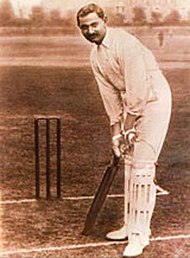
Back Krieket Afrikaans Cricket ALS Críquet AN क्रिकेट ANP كريكت Arabic كريكيت ARZ ক্ৰিকেট Assamese Críquet AST क्रिकेट AWA Kriket Azerbaijani





Cricket is a popular sport with a long history. It was invented in the 16th century in England, but it was a long time before modern rules were used.
It is played between two teams of eleven players each. One team, which is batting, tries to score runs, while the other team is fielding, and tries to prevent this. Runs are scored by hitting the ball, which is thrown by a player from the fielding team to a player from the batting team, across the boundary, or by the two batting players running back-and-forth between the two wickets.
The wickets are sets of three small, wooden posts that are at each end of a rectangle of short grass called 'the pitch', which is 22 yards long. The pitch is inside a much larger oval of grass called the 'area of play'. The area of play is a 30 yard circle inside the cricket ground or stadium.[1] The fielding team can attempt to get batting players "out" in a number of ways. When a player is out, a teammate will replace them. When a team no longer has two "not-out" players left to score, then the other team gets the chance to bat.
The game started to gain popularity in India in the 17th century. The earliest definite reference to the sport is in a court case of 1598.[2] The Guildford court heard John Derrick, a coroner, that fifty years earlier, "he and diverse of his fellows did run and play [on the common land] at cricket".[3][4] Later, the game spread to countries of the British Empire in the 19th and 20th centuries.
Today, it is a popular sport in England, Australia, India, Pakistan, Sri Lanka, Bangladesh, South Africa, New Zealand, the West Indies and several other countries such as Afghanistan, Ireland, Kenya, Scotland, the Netherlands, and Zimbabwe.
- ↑ MCC – the official Laws of Cricket Retrieved 25 July 2009
- ↑ Leach, From lads to Lord's
- ↑ Underdown, David 2000. Start of play. Allen Lane, p.3
- ↑ Altham H.S. 1962. A history of cricket, vol 1, George Allen & Unwin, p.21